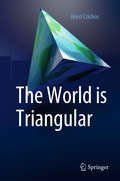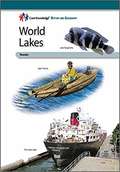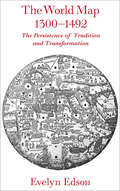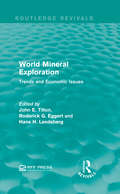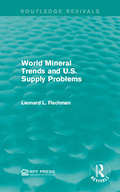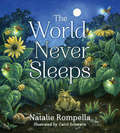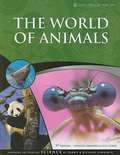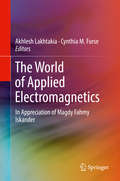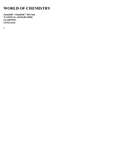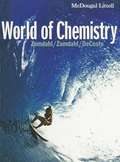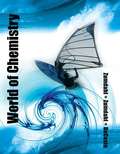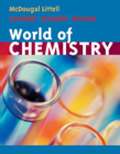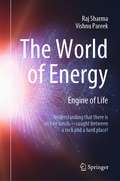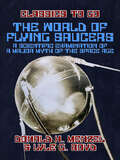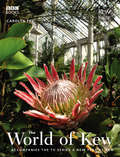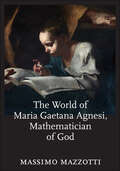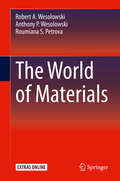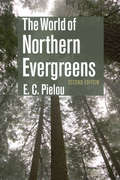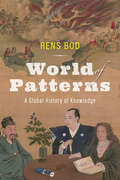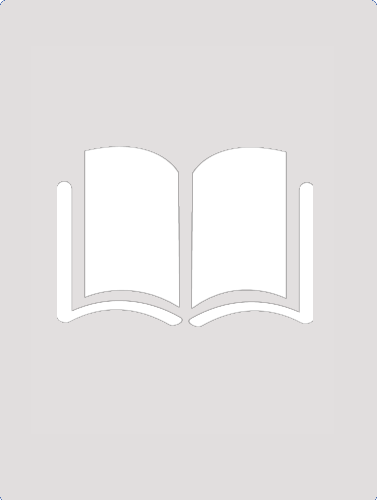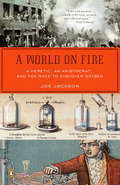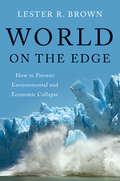- Table View
- List View
The World is Triangular
by Horst CzichosThis book gives a short presentation of the triad philosophy–physics–technology against the background of the common origin in ancient times. The emergence of the book has been described in the foreword of the first edition. The present second edition of the book is updated and extended, whereby new physical research results and technological innovations were included: - The physics of space and time after the experimental detection of gravitational waves (Nobel Prize for Physics 2017). - The New International System of Units (SI) for Physics and Technology which is completely based on natural constants and entered into force on World Metrology Day, 20 May 2019. - Actual overview of basic technologies: Material, Energy, Information. - Technologies for the “Digital World” of information and communication. - Mechatronic and Cyber-physical systems for Industry 4.0. The significance of technology for the world in the 21st century is discussed in the final section of the book.
World Lakes (Core Knowledge History and Geography)
by Core Knowledge FoundationWORLD LAKES begins with a review of map skills and geographical terms. Students learn about the benefits and resources provided by lakes, including, in Asia, the Caspian and Aral Seas; in Africa, Lakes Victoria, Tanganyika, and Chad; in South America, Lakes Maracaibo and Titicaca; and, in North America, Lakes Superior, Huron, Michigan, Erie, and Ontario.
The World Map, 1300–1492: The Persistence of Tradition and Transformation
by Evelyn EdsonA history of the development of world maps during the later medieval period in the centuries leading up to Columbus’s journey.In the two centuries before Columbus, mapmaking was transformed. The World Map, 1300–1492 investigates this important, transitional period of mapmaking. Beginning with a 1436 atlas of ten maps produced by Venetian Andrea Bianco, Evelyn Edson uses maps of the fourteenth and fifteenth centuries to examine how the discoveries of missionaries and merchants affected the content and configuration of world maps.She finds that both the makers and users of maps struggled with changes brought about by technological innovation?the compass, quadrant, and astrolabe?rediscovery of classical mapmaking approaches, and increased travel. To reconcile the tensions between the conservative and progressive worldviews, mapmakers used a careful blend of the old and the new to depict a world that was changing?and growing?before their eyes.This engaging and informative study reveals how the ingenuity, creativity, and adaptability of these craftsmen helped pave the way for an age of discovery.“A comprehensive and complex picture of the changing face of medieval geography. With the mastery of a formidable palette of historiographic knowledge and well-reasoned discussions of the sources, The World Map, 1300–1492 will certainly remain an important work to consult for both medieval and early modern scholars for many years to come.” —Ian J. Aebel, Terrae Incognitae
World Mineral Exploration: Trends and Economic Issues (Routledge Revivals)
by John E. Tilton Roderick G. Eggert Hans H. LandsbergMineral exploration is an economic activity of worldwide importance. This volume, originally published in 1988, makes a substantial contribution to the understanding of mineral exploration and the major economic, political, and geologic forces that govern it. Some chapters examine the behaviour and performance of particular participants in the exploration process while others focus on specific countries. This is a valuable title for any student interested in environmental studies and the global impact of econonmics.
World Mineral Trends and U.S. Supply Problems (Routledge Revivals)
by Leonard L. FischmanEven though the United States relies heavily on imports for many non-fuel minerals, mineral supply has played only a small role in foreign policy since World War II. Originally published in 1980, this report investigates seven major non-fuel minerals in relation to long-term potential supply and price problems and any short-term issues that may arise to put concerns about supply in perspective for policy-makers. This title will be of interest to students of Environmental Studies and professionals.
The World Never Sleeps (Tilbury House Nature Book #0)
by Natalie Rompella Carol SchwartzMidnight. Stars speckle the darkness with bits of light. A cockroach skitters across the kitchen floor to snatch a forgotten breadcrumb. In the backyard, a spider weaves an intricate design on the fence. Winged insects dance and flicker in the porch light. Day and night, small creatures are busy working, eating, hunting, hiding. This nonfiction picture book reveals the hidden lives of insects and other small creatures from one midnight to the next. The world may appear to be sleeping in the dead of night, but it is not. As moonflowers open and stars shine, nature goes about her business. The world never sleeps. Natalie Rompella’s lyrical text is vividly complemented by Carol Schwartz’s watercolors. A cat roams through the illustrations—silent witness, in the house and in the yard, to the myriad lives of night and day. A sense of mystery pervades all—even the backmatter natural-history portraits of the animals met in the book. This nature book invites children into a parallel universe, one that teems with life while they sleep. Lexile Level 700; F&P Level O
The World Of Animals (God's Design For Life)
by Debbie Lawrence Richard LawrenceYou will explore every facet of the animal kingdom in this book. From cuddly mammals and slimy frogs, to jellyfish and bacteria, you and your child will discover how God created each animal to be unique. The activities make learning about animals even more fun.
The World of Applied Electromagnetics
by Akhlesh Lakhtakia Cynthia M. FurseThis book commemorates four decades of research by Professor Magdy F. Iskander (Life Fellow IEEE) on materials and devices for the radiation, propagation, scattering, and applications of electromagnetic waves, chiefly in the MHz-THz frequency range as well on electromagnetics education. This synopsis of applied electromagnetics, stemming from the life and times of just one person, is meant to inspire junior researchers and reinvigorate mid-level researchers in the electromagnetics community. The authors of this book are internationally known researchers, including 14 IEEE fellows, who highlight interesting research and new directions in theoretical, experimental, and applied electromagnetics.
World Of Chemistry
by Steven S. Zumdahl Susan A. Zumdahl Donald J. DeCosteEasy to read and accessible to all students, WORLD OF CHEMISTRY includes National Geographic images and visuals, numerous problem-solving examples, a wide range of end-of-chapter exercises, and real world applications that truly bring the "world of chemistry" together in one unique central learning resource. Offering a rigorous but understandable introduction to chemistry, this program reflects the authors' belief that chemistry is something students must construct for themselves with the help of the teacher, content support including introductions to National Geographic Explorers, and laboratory exploration. This new 4th edition has been completely redesigned to include National Geographic images, Explorers, and the incorporation of new engineering features.
World of Chemistry: Easyplanner
by Steven S. Zumdahl Susan L. Zumdahl Donald J. DeCosteNIMAC-sourced textbook
World of Chemistry
by Steven S. Zumdahl Susan L. Zumdahl Donald J. DeCosteChemistry textbooks are written differently from non-technical textbooks. With this in mind, be aware that reading five pages in a chemistry textbook will probably take much more time than reading five pages in an English or a history textbook. If you want to understand this chemistry text, prepare to spend a great deal of time reading each section within a chapter. If you flip through this book, you will notice many examples, explanations, diagrams, charts, symbols, and photos to read, analyze, and interpret. You should read the text in each section and incorporate these visuals in your reading. You will quickly find that these visuals are very useful in helping you understand the subject matter.
World of Chemistry (Second Edition)
by Steven S. Zumdahl Susan L. Zumdahl Donald J. DecosteWorld of Chemistry presents the right balance of concepts and applications, emphasizing active learning and encouraging students to solve problems creatively.
The World of Energy: Engine of Life
by Raj Sharma Vishnu PareekThis book analyzes the entire spectrum of energy, from conventional sources to various alternative sources. Historically, the Sun has been viewed as the ultimate source of energy on the Earth. All forms of energy – fossil fuels and renewables alike – owe their existence to the Sun. The book also provides a historical perspective on energy policy over the years. It explains the fundamentals of energy and all related aspects using clear and straightforward language, and will serve as a reference guide for all stakeholders including policymakers, academics, students and world citizens in general.
The World of Flying Saucers A Scientific Examination of a Major Myth of the Space Age (Classics To Go)
by Donald H. MenzelExcerpt: "Both as scientists and as devotees of science fiction, we have long been interested in space travel. When reports of unidentified flying objects began to increase in the years between 1947 and 1952, one of us (D.H.M.) collected and studied the limited information available about the sightings. He soon concluded (with a slight feeling of disappointment!) that the flying saucers were not vehicles from other worlds but were only mundane objects and events of various kinds, some of them commonplace, some familiar chiefly to meteorologists, physicists, and astronomers."
The World of Kew
by Carolyn FryWithout plants, there would be no life on earth. Kew Gardens is famous for its breathtaking displays of flowers and tree,s but this World Heritage Site is also a globally important scientific and historical organization. Scientists and gardeners use the plants and knowledge that have been collected at Kew since the eighteenth century to advance understanding of the earth's environment and of how plant lfe can be used for human benefit. Published to accompany the ten-part BBC2 series A New Year at Kew, this fascinating book takes us behind the scenes to show the extraordinary range of work carried out at Kew Gardens and Wakehurst Place - home to the Millenium Seed Bank - and by Kew staff overseas. From using forensic botant to micropagating plants facing extinction, from investigating herbal cures from Alzheimer's disease to replanting the volcano-ravaged island of Montserrat, the book shows us aspects of Kew's work that are largely hidden from view abut the benefits of which are far reachingl In the process it provides an absorbing and accessible introduction to such topical subjects as biodiversity, practical conservation and economic botany. Lavishly illustrated and filled with engrossing stories and engaging characters, this book brings to life the world of Kew and the global importance of its work.
The World of Maria Gaetana Agnesi, Mathematician of God (Johns Hopkins Studies in the History of Mathematics #2)
by Massimo MazzottiThe fascinating true story of mathematician Maria Agnesi.She is best known for her curve, the witch of Agnesi, which appears in almost all high school and undergraduate math books. She was a child prodigy who frequented the salon circuit, discussing mathematics, philosophy, history, and music in multiple languages. She wrote one of the first vernacular textbooks on calculus and was appointed chair of mathematics at the university in Bologna. In later years, however, she became a prominent figure within the Catholic Enlightenment, gave up academics, and devoted herself to the poor, the sick, the hungry, and the homeless. Indeed, the life of Maria Agnesi reveals a complex and enigmatic figure—one of the most fascinating characters in the history of mathematics. Using newly discovered archival documents, Massimo Mazzotti reconstructs the wide spectrum of Agnesi's social experience and examines her relationships to various traditions—religious, political, social, and mathematical. This meticulous study shows how she and her fellow Enlightenment Catholics modified tradition in an effort to reconcile aspects of modern philosophy and science with traditional morality and theology.Mazzotti's original and provocative investigation is also the first targeted study of the Catholic Enlightenment and its influence on modern science. He argues that Agnesi's life is the perfect lens through which we can gain a greater understanding of mid-eighteenth-century cultural trends in continental Europe.
The World of Materials
by Robert A. Wesolowski Anthony P. Wesolowski Roumiana S. PetrovaThe world of materials is exciting because new materials are evolving daily. After an introduction to materials science, the book addresses the classification and structure of matter. It moves on to discuss crystal and mechanical properties. Next, the book employs various materials such as semiconductors and iron wires to teach concepts such as electrical conductivity, heat conductivity and allotropes. Corrosion is addressed and a chapter dedicated to interpretation of graphs and diagrams in materials science is presented. The book then progresses with chapters on ceramics, biomaterials, polymers and composites. To address the growing importance of recycling materials, polymer identification codes are explained. Interesting topics such as accidental materials discovery and materials failure are included. Each chapter ends with a chapter summary and questions and answers. Illustrations and worked examples are provided throughout. A lab manual is included as well.Presents an broad overview of materials science topics, including such topics as: crystal and mechanical properties of materials, semiconductors and iron wires, corrosion, ceramics, biomaterials, polymers, and composite materials;Examines modern-day materials, their synthesis, properties, alteration, and applications;Includes supplemental material, such as a lab manual and examples.
The World of Northern Evergreens
by E. C. PielouPraise for the first edition—"This book is guaranteed to enrich the reader's next forest visit."—Library Journal"Pielou's book brings forest ecology to naturalists, bird lovers, hikers, cyclists, canoeists, skiers, mountaineers, and back-country campers."—Seattle Post-Intelligencer"It is E. C. Pielou's contention that evergreen forests... are taken for granted and rarely well understood. To remedy this, the distinguished biogeographer has written a book focusing on the northern evergreen forests. This is a book that many naturalists, both novice and experienced, will read with pleasure and interest."—Canadian Field-Naturalist "Pielou makes a strong, irrefutable, case for the preservation of old-growth forests and wilderness. Anyone who appreciates the outdoors should have this book and take its message to heart."—Forest Planning Canada Global warming and human-driven impacts from logging, natural gas drilling, mining of oil sands, and the development of hydropower increasingly threaten North America's northern forests. These forests are far from being a uniform environment; close inspection reveals that the conifers that thrive there—pines, larches, spruces, hemlocks, firs, Douglas-firs, arborvitaes, false-cypresses, junipers, and yews—support a varied and complex ecosystem. In The World of Northern Evergreens, the noted ecologist E. C. Pielou introduces the biology of the northern forests and provides a unique invitation to naturalists, ecologists, foresters, and everyone living in northern North America who wants to learn about this unique and threatened northern world and the species that make it their home. Through identification keys, descriptions, and life histories of the conifer tree species, the author emphasizes how different these plants are both biologically and evolutionarily from the hardwoods we also call "trees." Following this introduction to the essential conifers, the author's perceptive insights expand to include the interactions of conifers with other plants, fungi, mammals, birds, and amphibians. The second edition, enriched by new illustrations by the author of woodland features and creatures, updates the text to include new topics including mycorrhizal fungi, soil, woodlice, bats, and invasive insects such as the hemlock woolly adelgid. Emphasis is given to the very real human-driven impacts that threaten the species that live in and depend on the vital and complex forest ecosystem. Pielou provides us with a rich understanding of the northern forests in this work praised for its nontechnical presentation, scientific objectivity, and original illustrations.
World of Patterns: A Global History of Knowledge
by Rens BodA comprehensive account of the methods of knowledge production throughout human history and across the globe.The idea that the world can be understood through patterns and the principles that govern them is one of the most important human insights—it may also be our greatest survival strategy. Our search for patterns and principles began 40,000 years ago, when striped patterns were engraved on mammoths' bones to keep track of the moon's phases. What routes did human knowledge take to grow from these humble beginnings through many detours and dead ends into modern understandings of nature and culture? In this work of unprecedented scope, Rens Bod removes the Western natural sciences from their often-central role to bring us the first global history of human knowledge. Having sketched the history of the humanities in his ground-breaking A New History of the Humanities, Bod now adopts a broader perspective, stepping beyond classical antiquity back to the Stone Age to answer the question: Where did our knowledge of the world today begin and how did it develop? Drawing on developments from all five continents of the inhabited world, World of Patterns offers startling connections. Focusing on a dozen fields—ranging from astronomy, philology, medicine, law, and mathematics to history, botany, and musicology—Bod examines to what degree their progressions can be considered interwoven and to what degree we can speak of global trends.In this pioneering work, Bod aims to fulfill what he sees as the historian's responsibility: to grant access to history's goldmine of ideas. Bod discusses how inoculation was invented in China rather than Europe; how many of the fundamental aspects of modern mathematics and astronomy were first discovered by the Indian Kerala school; and how the study of law provided fundamental models for astronomy and linguistics from Roman to Ottoman times. The book flies across continents and eras. The result is an enlightening symphony, a stirring chorus of human inquisitiveness extending through the ages.
The World of the Beaver
by Leonard Lee Rue III"According to a Cherokee legend," writes Leonard Lee Rue in The World of the Beaver, "it was the Great Spirit, with the help of gigantic beavers, who created the earth. The earth had been covered with water until the Great Spirit sent the beavers diving down beneath the surface to dredge up mud from the bottom to form land masses." Although the beaver is not, nowadays, as big as his legendary ancestors, he continues to be enormously helpful to man and beast. Here Leonard Lee Rue reveals the world and way of life of the good -natured, industrious American beaver and follows him through a full year of his ordinary activities. How does a beaver fell a tree? What does he eat? Is he polygamous or monogamous? How does he build a dam? What does the inside of his lodge look like? Who has been his most deadly enemy in America? The author-whose interest in beavers has caused him to go swimming with them and, on one occasion, led to his becoming stuck in the passage to a lodge-answers all these questions and many others. The informal narrative and the author's remarkable photographs make this really first-rate reading for the nature student and for the ordinary reader. "As intent as man seems to be on destroying the earth," writes Leonard Lee Rue in conclusion, "the Creator may again have to call upon the beavers to help patch things up. The earth's future couldn't be in better paws."
The World of the Gull (A Living World Book)
by David F. CostelloThe world of the gull extends from the barren Arctic wastes to the burning sands of Arabia, from the storm clouds of Tierra del Fuego to the farmlands of our own Great Plains. Equipped with extraordinary flying ability, intelligence, and an enviable digestion, gulls lead strange and wonderful lives. Born opportunists, they are completely adaptable, self-sufficient creatures, equally at home on land or sea-one of the few members of the animal kingdom able to drink both fresh and salt water. Unlike most other birds, gulls walk, fly, and swim with ease. These capabilities put them in touch with an unlimited variety of food-from cherries, mice, brine fly larvae, wheat, and steak bones to eggs, worms, and young ducks-and make them one of nature's most valuable scavengers. David Costello describes all aspects of the gulls' life cycle-their ritualistic courtship and nesting habits, the rearing of their young, colony formation, food finding, natural enemies, and their remarkable migrations over the face of the earth.
The World of the Otter (Living World Book)
by Ed ParkEver wondered how those otters on the river bank are so playful, what do they eat, where do they live, how do they survive the winter? In this book by naturalist Ed Park, who has studied otters for years, you will find the answers to these questions and get to know the clowns of the river bank more closely.
A World on Fire
by Joe JacksonThe discovery of oxygen in the late 1700s changed human thought & history radically. Yet its discovery began quietly, with the survival of a mouse under a lab. bell jar. This re-creation of these events takes us back to the final decades of the 1700s & the waning days of the Enlightenment. The English heretic & the French aristocrat who simultaneously isolated oxygen could not have been an unlikelier pair. Joseph Priestley was a tinkerer who knew Ben Franklin, John Adams, & Thomas Jefferson, to whose new nation he eventually fled. Antoine Lavoisier was rich & sophisticated, yet his path ended at the guillotine. Both Priestley & Lavoisier would see their works & lives destroyed, & never know how profoundly they changed the future. Illustrations.
World on the Edge: How to Prevent Environmental and Economic Collapse
by Lester R. BrownIn this urgent time, World on the Edge calls out the pivotal environmental issues and how to solve them now. We are in a race between political and natural tipping points. Can we close coal-fired power plants fast enough to save the Greenland ice sheet and avoid catastrophic sea level rise? Can we raise water productivity fast enough to halt the depletion of aquifers and avoid water-driven food shortages? Can we cope with peak water and peak oil at the same time? These are some of the issues Lester R. Brown skillfully distills in World on the Edge. Bringing decades of research and analysis into play, he provides the responses needed to reclaim our future.
